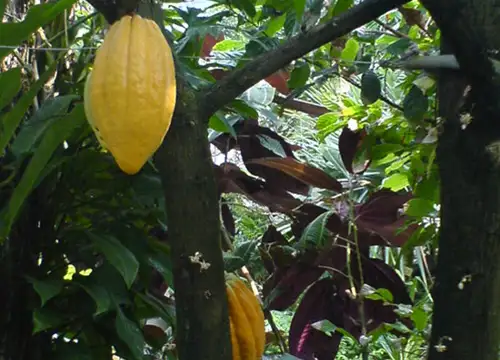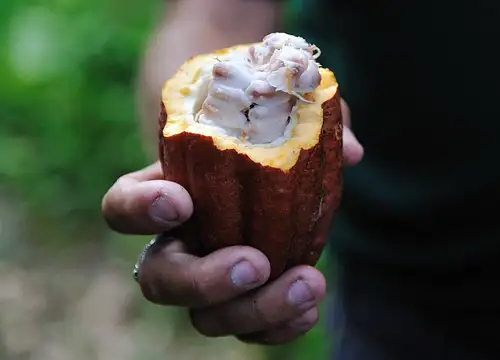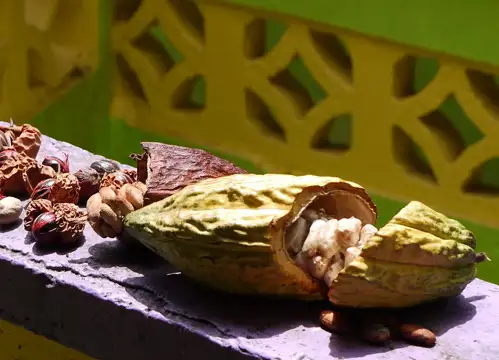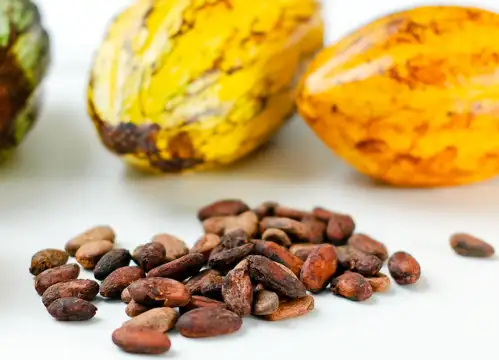Published:
Author: Antonio Maria Guerra
Modica Chocolate PGI
HISTORY, PLACES, INFO, INTERESTING FACTS

Let’s discover the history of Modica Chocolate, the sweet specialty from Sicily whose roots go back to the distant past, when the Italian island was dominated by the Kingdom of Spain. Let’s examine the fascinating events related to this delicacy, as well as the traditional method once used in its preparation. Let’s accompany it all with many interesting facts. Enjoy your reading!

What is Modica Chocolate?
Modica chocolate is a confectionery specialty closely linked to the Sicilian town from which it takes its name. It’s a particular type of chocolate, produced using a method of very ancient origins. Thanks the low temperature used in this process, the bars of this delicacy have a grainy consistency, clearly perceptible to the palate, and express an intense flavor that preserves the natural aroma of cocoa.
Fascinated by the History of Modica Chocolate? You will be even more so by deepening the knowledge of the speciality thanks fo this complete guide.


The history of Modica Chocolate.
In order to illustrate properly the origins of Modica chocolate, it’s necessary to go back to the time of the Spanish domination of southern Italy, which began in the 16th century, under the reign of Charles V (*1).
It was right at that time that the ‘conquistadors’, returning from the Americas, brought with them a plant hitherto unknown in Europe: cocoa, whose beans  were used by the Aztecs to prepare a bitter drink with almost miraculous qualities, the ‘xocoàtl’ (*2). In Modica, a county under the authority of the Kingdom of Spain and located in the south-east of Sicily, the technique of processing these beans was soon adopted. It was however necessary to wait until 1746 (*3) for the birth of Modica chocolate in the form we know still today, also thanks to the addition of sugar (unknown to the Mesoamerican populations).
were used by the Aztecs to prepare a bitter drink with almost miraculous qualities, the ‘xocoàtl’ (*2). In Modica, a county under the authority of the Kingdom of Spain and located in the south-east of Sicily, the technique of processing these beans was soon adopted. It was however necessary to wait until 1746 (*3) for the birth of Modica chocolate in the form we know still today, also thanks to the addition of sugar (unknown to the Mesoamerican populations).
During the 19th century, the speciality became the undisputed protagonist of the local confectionery tradition: in addition to the kitchens of noble families, it began to be prepared in monasteries and, later, in the town’s cafés. Its consumption took root to such an extent that the original product, characterised (among other things) by its typical granularity, managed to withstand the revolution caused by the invention of ‘conching ’ (*4): a technique that involves heating and slowly stirring the chocolate to obtain a smooth and homogenous consistency, therefore quite different from that of the Modican delicacy.
Still today, Modica chocolate is the standard-bearer of a unique taste, rooted in a distant past.
Notes:
*1: Charles V of Habsburg could boast a considerable number of titles, including German Emperor of the Holy Roman Empire, Archduke of Austria, as well as King of Naples and Sicily;
*2: The sacred drink included among its ingredients, in addition to roasted and ground cocoa beans, water (hot or cold), maize flour, pepper, chili pepper, honey, and vanilla.
*3: Valuable information about this is available in the archives of the noble Grimaldi family, settled in the County of Modica since the 16th century.
*4: The invention of the ‘conching’ technique dates back to 1879 and is attributed to Rodolphe Lindt.
Modica: the enchanting city of chocolate.
Modica, the home of the Modica Chocolate PGI, is a beautiful town in the province of Ragusa, located in the southeastern part of Sicily. It’s a place that seems to have stepped out of a painting, characterized by centuries of culture and an incomparable Baroque architecture: so special that it has been declared a UNESCO World Heritage Site.

The origin of the word ‘chocolate’.
The word ‘chocolate’ has fascinating origins closely linked to the ancient Mesoamerican peoples: it comes from ‘Xocoatl’,
Read more.
a name used by the Aztecs to indicate a sacred drink made from cocoa beans. When, in the 16th century, the fearsome Spanish ‘conquistadors’ came into contact with this culture, they adopted the term and changed it to ‘chocolate’. ‘Chocolate’ then spread across Europe, with slight variations ranging from the French ‘chocolat’ to the Italian ‘cioccolato’.

Modica chocolate: the traditional production method.
In the past (and, in part, still today), Modica chocolate was made according to a process inherited from the ancient Mesoamerican peoples, who used just a few, primitive tools (mainly the ‘metate’) to make a bitter drink ‘worthy of a god’. Let’s find out the technique used by the first Modican ‘cicolateri’ (chocolatiers).
1) The cocoa beans are roasted;
2) The husks of the beans are removed;
3) Using an arched, heated rolling pin, the ‘metate’, the beans are crushed;
4) Sugar is added, which may have been previously enriched with (e.g.) cinnamon, pistachio, chilli, etc.
5) The mixture is further worked on the ‘metate’, until it turns into a soft dough;
6) The paste is poured into special rectangular moulds;
7) Before the paste solidifies, the moulds are shaken (‘beating’) to make the contents homogenous and remove any air bubbles;
8) The chocolate ingots are taken out of the moulds, ready to be packaged;
Nowadays, most of the process just described is no longer performed manually, but using special machinery, such as the ‘melting/tempering machine’, which melts the cocoa mass at a temperature close to, but no higher than, 50°.
The production specification, which is closely linked to the recognition of the PGI mark, authorizes the use of these new technologies and seeks to reconcile the need to increase production with the one to preserve the authenticity and tradition of the specialiy.
Traditional preparation on video.
This fascinating video shows the traditional procedure used to make Modica Chocolate: a technique rooted in a distant pass. Many thanks to Federico di Rosa, the author of the video and owner of the YouTube channel.
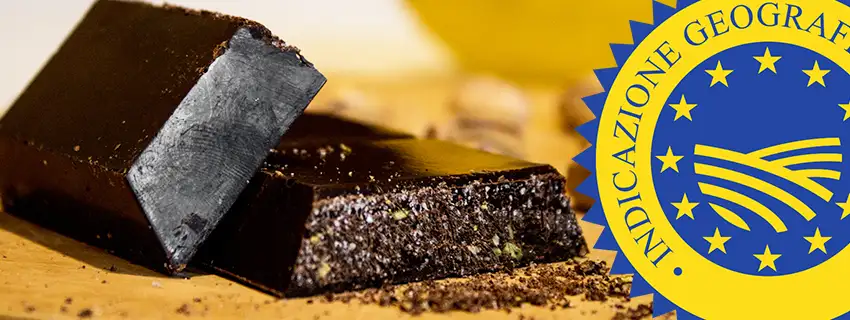
The PGI mark and the specification.
Given its uniqueness of its history anc characteristics, it should come as no surprise that, in 2018, Modica Chocolate was awarded the IGP mark (Protected Geographical Indication). This mark is linked to a specification document that strictly defines the characteristics that the original product must have.

No ‘conching’ for Modica Chocolate.
Modica Chocolate is distinguished from other similar products currently on the market for a particularly grainy texture. This peculiarity derives from the absence, during its preparation, of a generally used procedure: ‘conching’. Conching is a refining process, invented in 1879 by Rodolphe Lindt (yes, ‘that’ Lindt), which takes several hours to a few days and consists of stirring the chocolate at a high temperature. This makes it smooth, homogeneous, giving it a velvety texture. Modica Chocolate, on the other hand, by skipping this phase, remains, so to speak, ‘rough’ on the palate, with sugar crystals clearly perceptible to the palate.
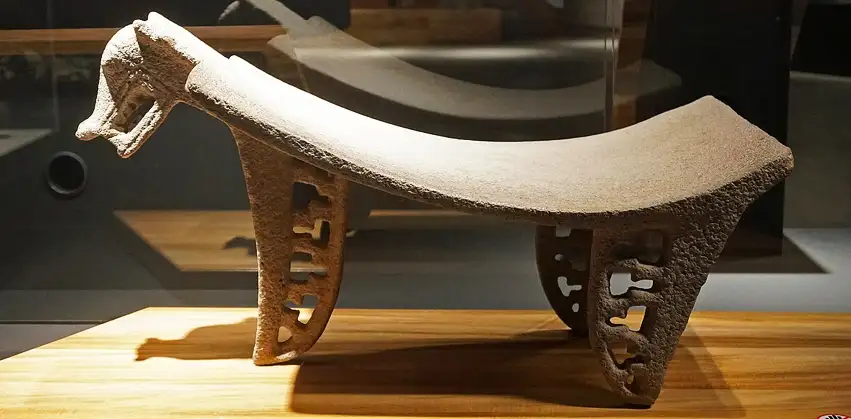
The history of Modica Chocolate: the ‘metate’.
The ‘metate’ is undoubtedly an instrument of great importance in the history of Modica Chocolate. It consists in a basaltic stone slab of volcanic origin, rectangular and concave in shape.
Read more.
Its first use is traced back to the legendary Olmecs and Aztecs: peoples that, countless centuries ago, used it to grind cocoa and maize, also thanks to a sort of rolling pin, made of stone, and called ‘hand’.

The Museum of Modica Chocolate.
Among the experiences not to be missed by any true fan of Modica Chocolate, is a visit to the museum dedicated to this delicacy, inaugurated in 2014 and housed in the rooms of the splendid Palazzo della Cultura in Modica. The exhibition illustrates the history of the specialty, from its ancient Central American origins to its incorporation into the local confectionery tradition. Not to be missed is “u dammusu ro ciucculattaru”: the exquisite replica of an 18th-century workshop, where master chocolatiers show visitors the most traditional method of preparation.
(More info in this article about the Museum)

The Consortium of Modica PGI Chocolate.
The Consorzio del Ciocolato di Modica, founded in 2003, gathers the most traditional producers of this speciality. Its main function is to preserve its authenticity, to guarantee its quality and to promote it on the market.
Contacts
Consorzio di Tutela del Cioccolato di Modica IGP.
Address: C.so Umberto I, 149
97015 Modica (RG) – ITALY
Official website: www.cioccolatodimodica.it
Mail: info@cioccolatodimodica.it
Tel.: +39 391 7391318
Copyright information.
The images displayed in this page belong to WebFoodCulture, with the exception of:
Public Domain Images:
- “Two Mixtec Kings drinking and giving teh cacao licour” by Mat Jones;
- “Charles V and Empress Isabella of Portugal” by Peter Paul Rubens
- “Landing_of_Columbus” by Architect of the Capitol;
- PGI Mark;
Creative Commons Images:
- “Cioccolato di M. , Sicilia / Pure Dark Chocolate“ by Monica Arellano-Ongpin is licenced under CC BY 2.0
- “Modica – Ragusa” by Massimo Frasson is licensed under CC BY-SA 2.0.
- “CioccolatoModicano2012-10” by Mussklprozz is licensed under CC BY-SA 3.0.
- “Modica StGeorgeCathedral 0215” by Ludvig14 is licensed under CC BY-SA 4.0.
- “Cacao” by Lifetime Travelmates is licensed under CC BY-SA 2.0.
- “Eurochocolate 2008” by Linda Tieu is licensed under CC BY 2.0.
- “Roasted cocoa beans, lightly crushed” by cstrom is licensed under CC BY-SA 2.0.
- “Metate de piedra con cabeza de jaguar” by Mariordo (Mario Roberto Durán Ortiz) is licensed under CC BY-SA 4.0 International
- “Metate del Museu de la Xocolata” (Barcelona) by Tamorlan is licensed under CC BY-SA 3.0.
- “Ciocc. di Modica” by Andrea Critti is licensed under CC BY 2.0.
- “Cocoa pods” by denn is licensed under CC BY-SA 2.0.
- “Fèves de cacao” by Rog01 is licensed under CC BY-SA 2.0.
- “Nutmeg and cocoa” by tristanf is licensed under CC BY 2.0.
- “Fresh Cacao from São Tomé & Príncipe” by EverJean is licensed under CC BY 2.0.
- “Cacao Seeds” by giulian.frisoni is licensed under CC BY 2.0.
- “Rubiel dries cacao on his farm” by World Bank Photo Collection is licensed under CC BY-NC-ND 2.0.
- “cocoa seeds” by lolay is licensed under CC BY 2.0.


